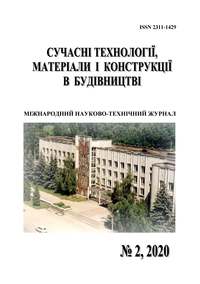ЗАБЕЗПЕЧЕННЯ КАРБОНІЗАЦІЙНОЇ СТІЙКОСТІ ГАЗОБЕТОНУ АВТОКЛАВНОГО ТВЕРДНЕННЯ
DOI:
https://doi.org/10.31649/2311-1429-2020-2-13-23Ключові слова:
автоклавний газобетон, карбонізація, активні мінеральні добавкиАнотація
Приведений аналіз тенденцій виробництва автоклавного газобетону. Враховуючи ціновий фактор, енерго-екологічні стан розвитку промисловості будівельних стінових і теплоізоляційних матеріалів, автоклавний газобетон має значні переваги перед традиційними стіновими матеріалами та перспективи розвитку виробництва.
Дослідження довговічності автоклавного газобетону викликані збільшенням його виробництва та використанням у будівельній галузі в останні роки у зв’язку зростанням вартості енергоносів, та необхідністю зменшення викидів парникових газів. При цьому густина газобетону зменшилась майже в 2 рази.
При переході на виробництво автоклавного газобетону низької густини D300, D150 з однієї сторони покращуються теплофізичні характеристики газобетону, зменшується матеріалоємність виробництва, з іншої – зростають питомі витрати в’яжучого (цементу) на одиницю маси газобетону та зростає його паро- та повітропроникність. Висока паропроникність та адсорбційні властивості водяних парів та газів з повітря несуть потенційну загрозу через можливу карбонізацію газобетону, «розшатування» макроструктури матеріалу при зволоженні і висушуванні, незворотніх деформаціях при заморожуванні і відтаюванні вологого газобетону, які відбуваються практично одночасно. За умови замочування, капілярного підсосу води та адсорбції водяних парів прискорюються процеси карбонізації автоклавного газобетону.
Матеріал може адсорбувати з повітря вологу та вуглекислий газ. Утворення вуглекислоти в складі газобетону приводить до зменшення лужного середовища, нейтралізації вільного вапна та руйнації гідросилікатів кальцію і корозії армованих виробів.
Карбонізація одночасно може позитивно і негативно впливати на цементні бетони. За безпечення карбонізаційної стійкості автоклавного газобетону має досягатись шляхом реалізацію низки технологічних рішень, які забезпечують підвищення карбонізаційної стійкості автоклавного газобетону при одночасному зменшені клінкерної складової в складі мінерального в’яжучого. Приведені результати використання природних мінеральних добавок гідравлічної та пуцоланічної дії в складі автоклавного газобетону.
Посилання
Alekseyev S. N., Rozental' N. K. Korrozionnaya stoykost' konstruktsiy v agressivnoy promyshlennoy srede. M.: Stroyizdat, 1976.205 s.
Shtark Y. Dolgovechnost' betona / Shtark Y., Vikht B. Per. s nem. – A. Tulaganova. Pod red. P. Krivenko. – Kiyev.: «Oranta», 2004. – 239 s.
Anikanova T.V., Rakhimbayev SH.M., Kaftayeva M.V. K voprosu o mekhanizme uglekislotnoy korrozii stroitel'nykh materialov // Fundamental'nyye issledovaniya. – 2015. – № 5-1. – S. 19-26.
Chen J.J., Thomas J.J., Jennings H.M. Decalcification shrinkage of cement paste. Cem. Concr. Res. 2006; 36: 801-809.
Shoshin Ye.A. Issledovaniye degradatsii nanostruktury C-S-H-faz modifitsirovannogo tsementnogo kamnya v protsesse dekal'tsinatsii / Ye. A. Shoshin, A. V. Polyakov, A. M. Burov // Vestnik BGTU im. V. G. Shukhova. - 2016. - № 2. - S. 25-31.
Sevelsted T.F., Skibsted J. Cement and Concrete Research Carbonation of C-S-H and C-A-S-H samples studied by 13 C, 27 Al and 29 Si MAS NMR spectroscopy. Cem. Concr. Res. 2015; 71: 56-65.
Babkov V.V.,Kuznetsov D.V., Gaysin A.M., Rezvov O.A., Samofeyev N.S. Problemy ekspluatatsionnoy nadezhnosti naruzhnykh sten zdaniy na osnove avtoklavnykh gazobetonnykh blokov i vozmozhnosti ikh zashchity ot uvlazhneniya. Inzhenerno-stroitel'nyy zhurnal, №8, 2010. – S.28-31.
Udachkin I. B., Aleksandrov G. G. Zashchita yacheistykh betonov ot korrozii.– Kiyev: Budivel'nik, 1982.– 80 s.
Vlasov V.V., Barsukova L.G., Krivneva G.G., Bautina Ye.V. Strukturnyye izmeneniya yacheistogo silikatnogo betona v ograzhdayushchikh konstruktsiyakh posle dlitel'noy ekspluatatsii/ Stroitel'nyye materialy. 2008. №1. – S.18-19.
How to cite this article: Zapotoczna-Sytek G. Durability of autoclaved aerated concrete based on polish experience. cepapers. 2018;2:53–62. https://doi.org/10.1002/cepa.850.
Silayenkov Ye. S. Dolgovechnost' izdeliy iz yacheistykh betonov. – M., Stroyizdat, 1986. – 176 s.
How to cite this article: Zapotoczna-Sytek G. Durability of autoclaved aerated concrete based on polish experience. cepapers. 2018;2:53–62. https://doi.org/10.1002/cepa.850.
Parrott LJ. Carbonation, moisture and empty pores. Adv Cem Res. 1992;4:111–118.
PN-EN 13295:2005. Products and systems for the protection and repair of concrete structures. Test methods. Determination of resistance to carbonation] í PN-EN 14630: 2007.
PN-EN 14630:2007. Products and systems for the protection and repair of concrete structures. Test methods. Determination of carbonation depth in hardened concrete by the phenolphthalein method].
Vorob'yev A.A., Yelfimov V.I. Vliyaniye karbonatnykh dobavok na dolgovechnost' yacheistykh betonov. Vesnik RUDN, ser. Inzhenernyye issledovaniya, 2001, №1,-S.86-89.
Rudchenko D.G., Dyuzhilova N.O, Serdyuk V.R. Otsínka mozhlivostí zastosuvannya domennikh granul'ovanikh shlakív v tekhnologíí̈ virobnitstva avtoklavnogo gazobetonu. Vísnik ODABA. Vipusk №79. 2020. –S.117-126.
Vínnits'ka ODA. Dopovíd' pro stan navkolishn'ogo prirodnogo seredovishcha u Vínnits'kíy oblastí. 2017. 247s. Elektronnyy resurs. Rezhim dostupa: https://geography.lnu.edu.ua/wp-content/uploads/2017/10/42320198.pdf.
Shtark Y., Bernd V. Tsement i izvest' / Per. s nem. A. Tulaganova pod red. P. Krivenko. – K.: Oranta, 2008. – 480s.
Kropivnits'ka T. P., Sanits'kiy M. A., Gev`yuk Í. M. Vpliv karbonatnikh dobavok na vlastivostí portlandtsementu kompozitsíynogo. Vísnik Natsíonal'nogo uníversitetu “L'vívs'ka polítekhníka” : Teoríya í praktika budívnitstva. 2013. № 755. - S. 214–220.
##submission.downloads##
-
PDF
Завантажень: 200
Опубліковано
Як цитувати
Номер
Розділ
Ліцензія

Ця робота ліцензується відповідно до Creative Commons Attribution 4.0 International License.


